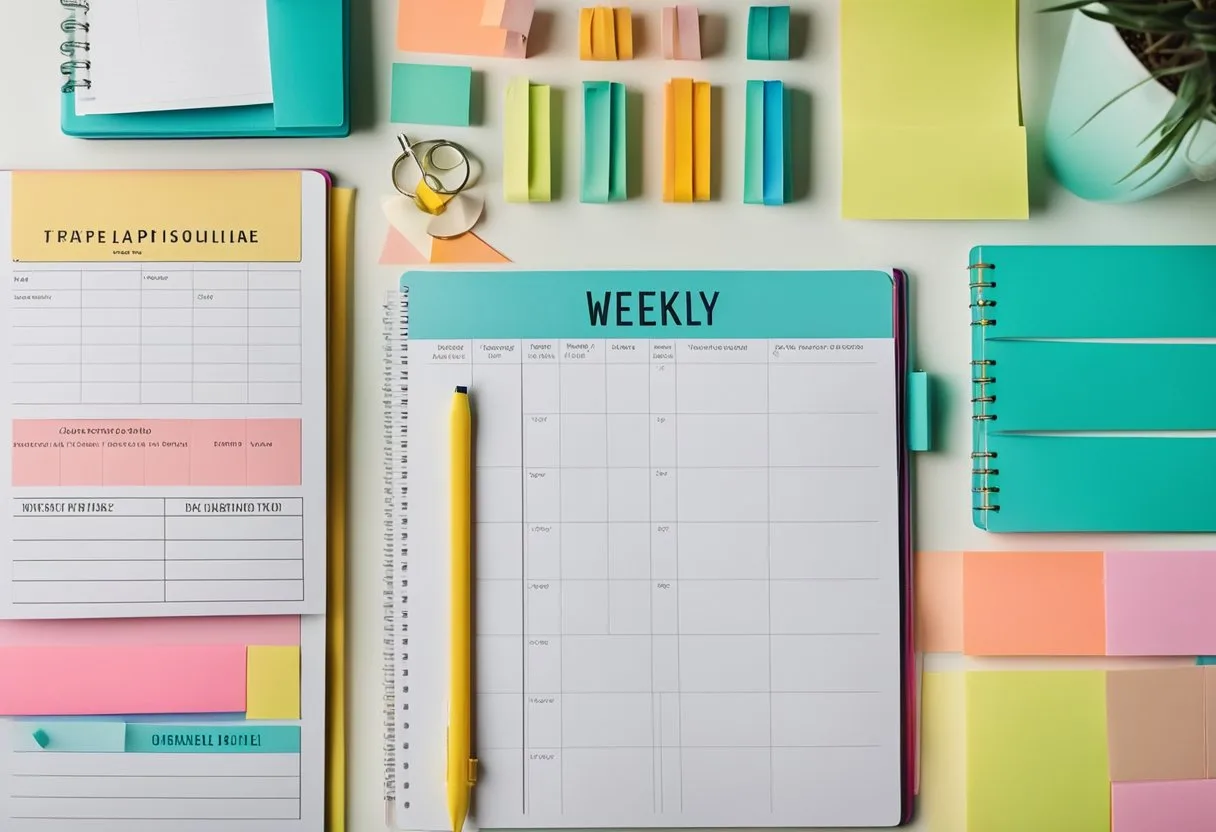Bullet journals and planners are two popular methods for organizing tasks, goals, and schedules. While both can be effective, they have distinct differences that may make one more suitable than the other depending on individual preferences and needs.
Bullet journals are highly customizable and allow for creative expression, as users can design their own layouts and add personal touches. They are also flexible, as pages can be added or removed as needed. On the other hand, planners typically have pre-printed layouts, which can be helpful for those who prefer a more structured approach to organization. Additionally, planners often include features such as goal-setting and habit-tracking pages, which can be useful for tracking progress towards long-term objectives.
Understanding Bullet Journals and Planners
Definition and Origin
Bullet Journals and Planners are two popular organizational systems used to manage tasks, events, and goals. The Bullet Journal was created by Ryder Carroll as a customizable system designed to help people track their daily tasks and to-do lists. Planners, on the other hand, are pre-designed calendars that allow users to plan and organize their schedule in advance.
Key Components
The Bullet Journal method consists of four key components: an index, a future log, a monthly log, and a daily log. The index is used to keep track of the content in the journal, while the future log is used to record events and tasks that are scheduled for months ahead.
The monthly log is used to plan and record events and tasks for the upcoming month, while the daily log is used to keep track of daily tasks and events. Planners typically include pre-designed calendars, to-do lists, and sections for notes and goal setting.
Common Uses
Bullet Journals are often used for habit tracking, goal setting, and personal reflection. Users can customize their Bullet Journals to fit their specific needs, making it a versatile organizational system. Planners, on the other hand, are often used for work-related tasks and scheduling.
They provide a pre-designed structure that can help users stay on track with their daily tasks and appointments. Both Bullet Journals and Planners can be effective organizational systems, depending on the user’s needs and preferences.
Bullet Journal vs Planner
Bullet journal and planner are two popular organizational systems that help individuals keep track of their daily tasks, appointments, and goals. While both systems share some similarities, they also have some key differences.
Differences
- Customizability: One of the main differences between a bullet journal and a planner is the level of customization they offer. Bullet journals are highly customizable and allow users to create their own layouts, trackers, and collections. On the other hand, planners come with pre-designed layouts and are less customizable.
- Habit tracking: Bullet journals are great for habit tracking as they allow users to create habit trackers and monitor their progress. Planners, on the other hand, do not offer this feature.
- Bullet journal method: Bullet journals are based on the bullet journal method created by Ryder Carroll. This method involves using symbols and short sentences to organize tasks, events, and notes. Planners do not follow this method and use pre-designed layouts instead.
Similarities
- Organization: Both bullet journals and planners are designed to help individuals stay organized and keep track of their daily tasks, appointments, and goals.
- Goal setting: Both systems allow users to set and track their goals, whether they are short-term or long-term.
- Time management: Both bullet journals and planners are effective tools for managing time and prioritizing tasks.
While bullet journals and planners may have some differences, they both offer effective ways to stay organized and productive. The choice between the two ultimately depends on an individual’s personal preferences and needs.
Comparing Structure and Customization
Layout and Design
One of the primary differences between bullet journals and planners is the layout and design. Planners usually come with pre-designed layouts that are structured to fit daily, weekly, or monthly schedules.
On the other hand, bullet journals have a blank canvas where the user can create their own layouts and designs. This means that bullet journals offer a lot more flexibility when it comes to creating a personalized layout.
Flexibility and Personalization
Bullet journals offer a high level of flexibility and personalization. Users can create their own designs and layouts, making it easier to track their goals, habits, and daily tasks. This level of customization is not available in planners, which have pre-set layouts that may not fit the user’s specific needs.
Bullet journals allow users to be creative and use different colors, stickers, and other decorations to make their journal unique.
Ease of Use for Beginners
For beginners, planners may be easier to use than bullet journals. Planners come with pre-designed layouts that are easy to follow, making it easier to stay organized. Bullet journals, on the other hand, require more effort and creativity to create a layout that works for the user.
However, once the user becomes more familiar with bullet journaling, they may find that it offers more flexibility and personalization than a planner.
The choice between a bullet journal and a planner depends on the user’s needs and preferences. Those who prefer pre-designed layouts and ease of use may find planners more suitable, while those who prefer flexibility and customization may find bullet journals more appealing.
Evaluating Practicality and Functionality
Task and Goal Management
Bullet journals and planners both offer a practical way to manage tasks and goals. While a planner provides pre-made layouts for daily, weekly, and monthly tasks, a bullet journal offers the flexibility to design your own layout.
A bullet journal is ideal for those who prefer to keep their tasks and goals organized in a personalized manner. On the other hand, a planner is perfect for those who prefer a more structured approach to task and goal management.
Tracking Habits and Appointments
Bullet journals and planners both provide the option to track habits and appointments. Habit trackers in bullet journals are designed to help users keep track of their daily habits, while appointment trackers in planners help users keep track of their appointments.
A bullet journal is ideal for those who prefer to track their habits in a personalized manner, while a planner is perfect for those who prefer a more structured approach to tracking appointments.
Reflection and Mindfulness
Bullet journals offer a unique opportunity for reflection and mindfulness. Gratitude logs, reflection prompts, and mindfulness exercises can be included in a bullet journal to encourage users to reflect on their daily experiences and practice mindfulness.
While some planners may include prompts for reflection and mindfulness, a bullet journal provides more space for personalization and creativity. A bullet journal is ideal for those who prioritize reflection and mindfulness in their daily routine.
Both bullet journals and planners offer practicality and functionality in their own unique ways. While a bullet journal provides flexibility and personalization, a planner offers structure and pre-made layouts. Ultimately, the choice between the two depends on personal preference and individual needs.
Considering Costs and Accessibility
Price Points and Brands
When it comes to cost, bullet journals and planners can vary widely depending on the brand and size. Some bullet journals can be expensive, especially if they are made by well-known brands like Moleskine or Filofax. Similarly, some planners can be more expensive than others, especially if they are made by popular brands like Erin Condren or Happy Planner.
However, there are also many affordable options available, especially if you shop around at different stationery stores or craft chains. Amazon is also a great place to find affordable bullet journals and planners.
Availability and Accessories
Another factor to consider when choosing between a bullet journal and a planner is availability and accessories. While bullet journals can be found at many stationery stores and online retailers, they are not as widely available as planners. Additionally, bullet journals may require more accessories like washi tape or stickers to make them visually appealing and functional.
On the other hand, planners often come with built-in accessories like pockets and dividers. Ultimately, the decision between a bullet journal and a planner will depend on personal preference and budget.
Frequently Asked Questions
What are the core differences between a bullet journal and a traditional planner?
Bullet journals are more flexible and customizable than traditional planners. Bullet journals are designed to be a blank canvas where users can create their own layouts, symbols, and collections to fit their specific needs. Traditional planners, on the other hand, have pre-designed layouts and sections that may not be as flexible.
How does bullet journaling accommodate beginners compared to traditional planners?
Bullet journaling can be more intimidating for beginners because it requires more creativity and planning. However, many bullet journaling resources are available online, including templates, tutorials, and inspiration. Traditional planners are typically easier for beginners to use because they have pre-designed layouts and sections.
What are the pros and cons of using a bullet journal versus a digital planner?
Bullet journals are more customizable and allow for more creativity than digital planners. However, digital planners are more portable and can be accessed on multiple devices. Additionally, digital planners can be more efficient for users who prefer typing over handwriting.
Can a bullet journal serve the same organizational purposes as a monthly planner?
Yes, a bullet journal can serve the same organizational purposes as a monthly planner. Bullet journals can be designed to include monthly calendars, habit trackers, and other organizational tools commonly found in monthly planners.
In what ways do silk journals differ from bullet journals in terms of functionality?
Silk journals are typically more decorative and stylish than bullet journals. However, silk journals may not be as functional as bullet journals because they may not have as much space for planning and organizing.
Is a bullet journal a worthwhile investment for personal organization?
Yes, a bullet journal can be a worthwhile investment for personal organization. Bullet journals are highly customizable and can be tailored to fit the specific needs of the user. Additionally, bullet journaling can be a creative and therapeutic outlet for many people.




